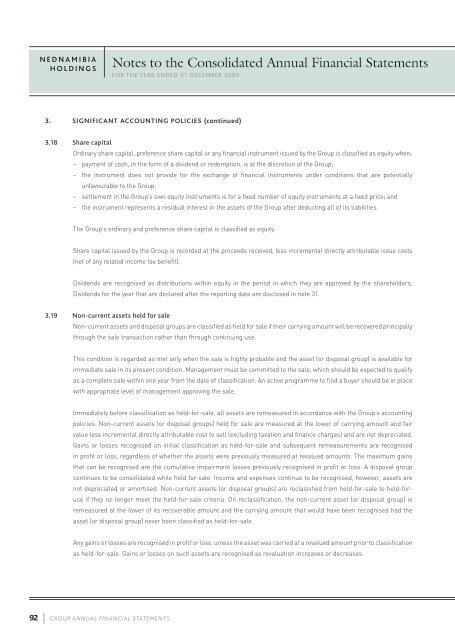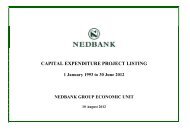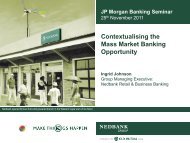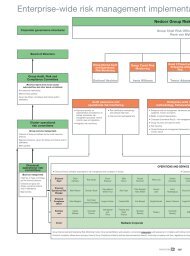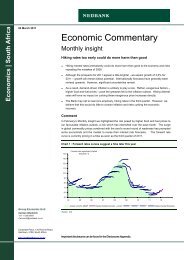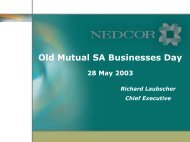2009 Annual report - Nedbank Group Limited
2009 Annual report - Nedbank Group Limited
2009 Annual report - Nedbank Group Limited
You also want an ePaper? Increase the reach of your titles
YUMPU automatically turns print PDFs into web optimized ePapers that Google loves.
N E D N A M I B I AH O L D I N G SNotes to the Consolidated <strong>Annual</strong> Financial StatementsFOR THE YEAR ENDED 31 DECEMBER <strong>2009</strong>3. significant ACCOUNTING POLICIES (continued)3.18 Share capitalOrdinary share capital, preference share capital or any financial instrument issued by the <strong>Group</strong> is classified as equity when:– payment of cash, in the form of a dividend or redemption, is at the discretion of the <strong>Group</strong>;– the instrument does not provide for the exchange of financial instruments under conditions that are potentiallyunfavourable to the <strong>Group</strong>;– settlement in the <strong>Group</strong>’s own equity instruments is for a fixed number of equity instruments at a fixed price; and– the instrument represents a residual interest in the assets of the <strong>Group</strong> after deducting all of its liabilities.The <strong>Group</strong>’s ordinary and preference share capital is classified as equity.Share capital issued by the <strong>Group</strong> is recorded at the proceeds received, less incremental directly attributable issue costs(net of any related income tax benefit).Dividends are recognised as distributions within equity in the period in which they are approved by the shareholders.Dividends for the year that are declared after the <strong>report</strong>ing date are disclosed in note 31.3.19 Non-current assets held for saleNon-current assets and disposal groups are classified as held for sale if their carrying amount will be recovered principallythrough the sale transaction rather than through continuing use.This condition is regarded as met only when the sale is highly probable and the asset (or disposal group) is available forimmediate sale in its present condition. Management must be committed to the sale, which should be expected to qualifyas a complete sale within one year from the date of classification. An active programme to find a buyer should be in placewith appropriate level of management approving the sale.Immediately before classification as held-for-sale, all assets are remeasured in accordance with the <strong>Group</strong>’s accountingpolicies. Non-current assets (or disposal groups) held for sale are measured at the lower of carrying amount and fairvalue less incremental directly attributable cost to sell (excluding taxation and finance charges) and are not depreciated.Gains or losses recognised on initial classification as held-for-sale and subsequent remeasurements are recognisedin profit or loss, regardless of whether the assets were previously measured at revalued amounts. The maximum gainsthat can be recognised are the cumulative impairment losses previously recognised in profit or loss. A disposal groupcontinues to be consolidated while held for sale. Income and expenses continue to be recognised, however, assets arenot depreciated or amortised. Non-current assets (or disposal groups) are reclassified from held-for-sale to held-foruseif they no longer meet the held-for-sale criteria. On reclassification, the non-current asset (or disposal group) isremeasured at the lower of its recoverable amount and the carrying amount that would have been recognised had theasset (or disposal group) never been classified as held-for-sale.Any gains or losses are recognised in profit or loss, unless the asset was carried at a revalued amount prior to classificationas held-for-sale. Gains or losses on such assets are recognised as revaluation increases or decreases.92 G RO U P A N N U A L F I N A N C I A L STAT E M E N T S


